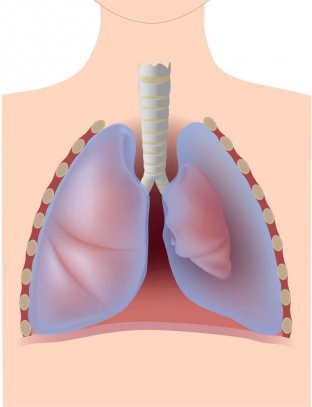Pneumothorax is a pathology of the lungs, which is accompanied by the presence of air between the layers of the pleura, which separate the lungs from the chest wall. The air in pneumothorax enters between these two layers of the pleura and is unable to exit. Pneumothorax can cause the lungs to collapse at the bottom. This is manifested by chest pain and shortness of breath. In most cases, pneumothorax is unilateral. What is the clinical course of pneumothorax? What is the mechanism of development of pneumothorax and how to treat this pathology, read in our article.
Who is prone to developing pneumothorax? Causes and mechanism of development of pneumothorax
The lung tissue is made up of alveoli, which are air sacs. If the alveolus is enlarged, then it is called a papal bull. Most of these bullae are present from birth. Rupture of such bullae can occur at rest, but more often occurs during physical exertion. Bull rupture is more common in thin young people.
People who have bullae from birth are more likely to develop pneumothorax during exercise.
Pneumothorax can develop as a complication of pathological lung processes. This is bronchial asthma, chronic obstructive pulmonary disease.
The following conditions can provoke the development of pneumothorax:
- Marfan's syndrome, in which the connective tissue is affected, which leads to a violation of the structure and function of the heart, bones and eyes.
- Penetrating wounds to the chest, rib fractures, and surgery in the chest cavity can also provoke pneumothorax.
How does pneumothorax manifest itself? Symptoms of the development of pneumothorax
Pneumothorax is characterized by sudden, severe pain in the chest. In rare cases, the pain is not intense and causes only minor discomfort. Breathing is disturbed, shortness of breath appears. With exacerbated pneumothorax, the patient feels acute pain and shortness of breath. At the same time, ventilation of the lungs is disturbed, the skin acquires a slightly bluish tint. The intensity of shortness of breath depends on the amount of air between the layers of the pleura.
During the period of exacerbation of pneumothorax, the air entering between the layers of the pleura is not able to return, which increases the pressure in the pleural layers. This causes severe shortness of breath and can be fatal for the patient. This condition requires immediate treatment.
 Pneumothorax increases pressure in the pulmonary circulation, preventing blood from returning to the heart from the lungs. This provokes the development of hypotension, fainting and shock.
Pneumothorax increases pressure in the pulmonary circulation, preventing blood from returning to the heart from the lungs. This provokes the development of hypotension, fainting and shock.
Methods of treatment of pneumothorax. Use of pleurodesis for pneumothorax
Chest x-ray is performed to confirm the diagnosis. The pneumothorax of the initial stages disappears within a few days, as the air is absorbed by the tissues of the body. With extensive pneumothorax, as well as in the presence of concomitant lung pathologies, pneumothorax is treated in a hospital. Air is taken from the pleural cavity with a syringe under local anesthesia. Extensive pneumothorax requires the insertion of tubes to remove air. Such manipulation immediately alleviates the patient's condition.
If the air does come back, pleurodesis is used to prevent collapse of the lung. In this procedure, a chemical irritant is injected between the layers of the pleura to keep the layers together. It is important to note that pleurodesis does not always bring the desired effect, therefore, surgical intervention is often resorted to. In every fifth patient, a case of pneumothorax recurs throughout the year, which does not depend on the quality of treatment.







Add a comment